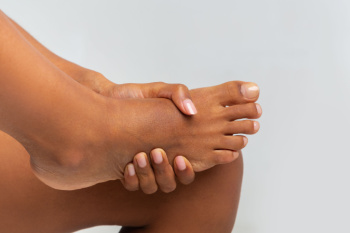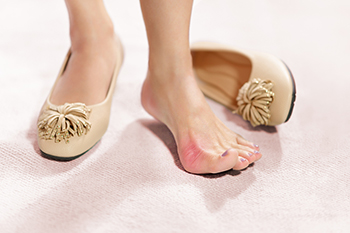Blog
Items filtered by date: June 2024
Caregiver Help in Everyday Foot Care
 Caregivers play a vital role in maintaining the foot and toenail health of those they assist. Regular inspection of the feet is important, checking for any signs of redness, swelling, cuts, or infections. Toenails should be trimmed straight across to prevent ingrown toenails, and the edges can be gently filed to remove sharp corners. Keeping feet clean and dry helps prevent fungal infections, while moisturizing can prevent dry, cracked skin. It is also important to ensure that shoes and socks fit properly to avoid pressure points and blisters. Elevating the feet periodically can improve circulation, especially for those who are less mobile. Any signs of infection or persistent foot problems should be addressed promptly. If you are a caregiver, it is suggested that you include a podiatrist on the healthcare team to ensure specialized care and early intervention for any foot-related issues.
Caregivers play a vital role in maintaining the foot and toenail health of those they assist. Regular inspection of the feet is important, checking for any signs of redness, swelling, cuts, or infections. Toenails should be trimmed straight across to prevent ingrown toenails, and the edges can be gently filed to remove sharp corners. Keeping feet clean and dry helps prevent fungal infections, while moisturizing can prevent dry, cracked skin. It is also important to ensure that shoes and socks fit properly to avoid pressure points and blisters. Elevating the feet periodically can improve circulation, especially for those who are less mobile. Any signs of infection or persistent foot problems should be addressed promptly. If you are a caregiver, it is suggested that you include a podiatrist on the healthcare team to ensure specialized care and early intervention for any foot-related issues.
Everyday foot care is very important to prevent infection and other foot ailments. If you need your feet checked, contact Queen Mbanuzue, DPM from In Step Podiatry Center. Our doctor can provide the care you need to keep you pain-free and on your feet.
Everyday Foot Care
Often, people take care of their bodies, face and hair more so than they do for their feet. But the feet are a very important aspect of our bodies, and one that we should pay more attention to. Without our feet, we would not be able to perform most daily tasks.
It is best to check your feet regularly to make sure there are no new bruises or cuts that you may not have noticed before. For dry feet, moisturizer can easily be a remedy and can be applied as often as necessary to the affected areas. Wearing shoes that fit well can also help you maintain good foot health, as well as making it easier to walk and do daily activities without the stress or pain of ill-fitting shoes, high heels, or even flip flops. Wearing clean socks with closed shoes is important to ensure that sweat and bacteria do not accumulate within the shoe. Clean socks help to prevent Athlete’s foot, fungi problems, bad odors, and can absorb sweat.
If you have any questions please feel free to contact our office located in Lanham, MD . We offer the newest diagnostic and treatment technologies for all your foot and ankle needs.
Bunions and Their Effects on Women

Bunions, or hallux valgus, disproportionately affect women, significantly impacting their overall foot health. Women are particularly susceptible due to factors like frequent wearing of high-heeled or narrow shoes, along with genetic predispositions. The risk of bunions has been shown to increase with age. The formation of a bunion starts with the big toe bending toward the smaller toes, which leads to a painful bony protrusion on the side of the foot. As bunions progress, they disrupt the alignment and function of adjacent toes. This often leads to formation of hammertoes or claw toes, altered weight distribution, corns and calluses. Research suggests that the severity of bunions correlates with increased pain not only in the feet but also in other parts of the body. Family history and flat feet are other contributing factors to the development of bunions. Addressing bunion deformity through early and effective interventions can offer significant relief and improve overall quality of life. If you are experiencing bunion-related discomfort, it is suggested that you make an appointment with a podiatrist for an exam and treatment.
If you are suffering from bunions, contact Queen Mbanuzue, DPM of In Step Podiatry Center. Our doctor can provide the care you need to keep you pain-free and on your feet.
What Is a Bunion?
A bunion is formed of swollen tissue or an enlargement of boney growth, usually located at the base joint of the toe that connects to the foot. The swelling occurs due to the bones in the big toe shifting inward, which impacts the other toes of the foot. This causes the area around the base of the big toe to become inflamed and painful.
Why Do Bunions Form?
Genetics – Susceptibility to bunions are often hereditary
Stress on the feet – Poorly fitted and uncomfortable footwear that places stress on feet, such as heels, can worsen existing bunions
How Are Bunions Diagnosed?
Doctors often perform two tests – blood tests and x-rays – when trying to diagnose bunions, especially in the early stages of development. Blood tests help determine if the foot pain is being caused by something else, such as arthritis, while x-rays provide a clear picture of your bone structure to your doctor.
How Are Bunions Treated?
- Refrain from wearing heels or similar shoes that cause discomfort
- Select wider shoes that can provide more comfort and reduce pain
- Anti-inflammatory and pain management drugs
- Orthotics or foot inserts
- Surgery
If you have any questions, please feel free to contact our office located in Lanham, MD . We offer the newest diagnostic and treatment technologies for all your foot care needs.
Get Professional Care for a Broken Foot or Ankle
Arthritis and the Feet
 Arthritis can significantly impact the feet, leading to pain, swelling, and difficulty in walking. Several types of arthritis can affect the feet, with osteoarthritis and rheumatoid arthritis being the most common. Osteoarthritis, often referred to as wear-and-tear arthritis, occurs when the protective cartilage that cushions the ends of bones wears down over time. This can lead to pain and stiffness in the feet, particularly in the joints of the toes and ankles. Rheumatoid arthritis, on the other hand, is an autoimmune condition where the body's immune system attacks the joints, causing inflammation and deformity. Treatment options for arthritis in the feet vary depending on the type and severity of the condition. They may include medication to reduce pain and inflammation, exercise to improve joint function and mobility, and orthotic devices to support the feet. In severe cases, surgery may be necessary to repair or replace damaged joints. If you are experiencing foot pain or discomfort due to arthritis, it is suggested that you schedule an appointment with a podiatrist who can provide specialized care and a tailored treatment plan to alleviate the symptoms, and improve your quality of life.
Arthritis can significantly impact the feet, leading to pain, swelling, and difficulty in walking. Several types of arthritis can affect the feet, with osteoarthritis and rheumatoid arthritis being the most common. Osteoarthritis, often referred to as wear-and-tear arthritis, occurs when the protective cartilage that cushions the ends of bones wears down over time. This can lead to pain and stiffness in the feet, particularly in the joints of the toes and ankles. Rheumatoid arthritis, on the other hand, is an autoimmune condition where the body's immune system attacks the joints, causing inflammation and deformity. Treatment options for arthritis in the feet vary depending on the type and severity of the condition. They may include medication to reduce pain and inflammation, exercise to improve joint function and mobility, and orthotic devices to support the feet. In severe cases, surgery may be necessary to repair or replace damaged joints. If you are experiencing foot pain or discomfort due to arthritis, it is suggested that you schedule an appointment with a podiatrist who can provide specialized care and a tailored treatment plan to alleviate the symptoms, and improve your quality of life.
Arthritis can be a difficult condition to live with. If you are seeking treatment, contact Queen Mbanuzue, DPM from In Step Podiatry Center. Our doctor can provide the care you need to keep you pain-free and on your feet.
Arthritic Foot Care
Arthritis is a term that is commonly used to describe joint pain. The condition itself can occur to anyone of any age, race, or gender, and there are over 100 types of it. Nevertheless, arthritis is more commonly found in women compared to men, and it is also more prevalent in those who are overweight. The causes of arthritis vary depending on which type of arthritis you have. Osteoarthritis for example, is often caused by injury, while rheumatoid arthritis is caused by a misdirected immune system.
Symptoms
- Swelling
- Pain
- Stiffness
- Decreased Range of Motion
Arthritic symptoms range in severity, and they may come and go. Some symptoms stay the same for several years but could potentially get worse with time. Severe cases of arthritis can prevent its sufferers from performing daily activities and make walking difficult.
Risk Factors
- Occupation – Occupations requiring repetitive knee movements have been linked to osteoarthritis
- Obesity – Excess weight can contribute to osteoarthritis development
- Infection – Microbial agents can infect the joints and trigger arthritis
- Joint Injuries – Damage to joints may lead to osteoarthritis
- Age – Risk increases with age
- Gender –Most types are more common in women
- Genetics – Arthritis can be hereditary
If you suspect your arthritis is affecting your feet, it is crucial that you see a podiatrist immediately. Your doctor will be able to address your specific case and help you decide which treatment method is best for you.
If you have any questions, please feel free to contact our office located in Lanham, MD . We offer the newest diagnostic and treatment technologies for all your foot care needs.
Surgery on the Small Toes

When it comes to foot surgery, attention often gravitates toward major procedures, like bunion corrections or ankle reconstructions. However, surgeries targeting the smaller toes hold equal significance, addressing various conditions that can profoundly impact mobility and comfort. One prevalent issue necessitating such interventions is hammertoe, characterized by abnormal bending of the toe joints, often resulting from imbalanced foot mechanics or ill-fitting footwear. Left untreated, hammertoes can lead to pain, corns, and difficulty in wearing shoes. Another common concern is claw toe, where the toe bends upward from the joint at the ball of the foot, causing pressure points and discomfort. These conditions may be worsened by genetics, arthritis, or nerve damage. Foot surgery for the smaller toes aims to realign and stabilize the affected joints, relieve pain, and restore function. If you have an abnormal foot structure that is affecting the small toes, it is suggested that you seek the advice of a podiatrist who can determine if surgery is a viable option for you.
Foot surgery is sometimes necessary to treat a foot ailment. To learn more, contact Queen Mbanuzue, DPM of In Step Podiatry Center. Our doctor will assist you with all of your foot and ankle needs.
When Is Surgery Necessary?
Foot and ankle surgery is generally reserved for cases in which less invasive, conservative procedures have failed to alleviate the problem. Some of the cases in which surgery may be necessary include:
- Removing foot deformities like bunions and bone spurs
- Severe arthritis that has caused bone issues
- Cosmetic reconstruction
What Types of Surgery Are There?
The type of surgery you receive will depend on the nature of the problem you have. Some of the possible surgeries include:
- Bunionectomy for painful bunions
- Surgical fusion for realignment of bones
- Neuropathy decompression surgery to treat nerve damage
Benefits of Surgery
Although surgery is usually a last resort, it can provide more complete pain relief compared to non-surgical methods and may allow you to finally resume full activity.
Surgical techniques have also become increasingly sophisticated. Techniques like endoscopic surgery allow for smaller incisions and faster recovery times.
If you have any questions please feel free to contact our office located in Lanham, MD . We offer the newest diagnostic and treatment technologies for all your foot and ankle needs.
Blog Archives
- January 2025
- December 2024
- November 2024
- October 2024
- September 2024
- August 2024
- July 2024
- June 2024
- May 2024
- April 2024
- March 2024
- February 2024
- January 2024
- December 2023
- November 2023
- October 2023
- September 2023
- August 2023
- July 2023
- June 2023
- May 2023
- April 2023
- March 2023
- February 2023
- January 2023
- December 2022
- November 2022
- October 2022
- September 2022
- August 2022
- July 2022
- June 2022
- May 2022
- April 2022
- March 2022


